
|   |

|   |
16th Annual Dance and Music Festival of Gunjan Dance Academy - Dr. Sunil Kothari e-mail: sunilkothari1933@gmail.com November 25, 2012 Meera Das is a senior exponent of Odissi dance, trained under Guru Kelucharan Mohapatra at Odissi Research Centre, Bhubaneswar, along with Sujata Mohapatra, Bichitrananda Swain and others, when celebrated dancer Kum Kum Mohanty was in charge of the Research Centre. A seasoned dancer, Meera Das runs her Gunjan Dance Academy at Cuttack imparting training in Odissi, performing, choreographing, travelling within India and abroad and has made a name for herself as a leading dancer and a choreographer. The four day festival of dance and music was flagged off on 17th November at Shaheed Bhavan, the spacious auditorium at Cuttack. I could arrive on the 18th November only, and therefore missed the program on the first day. Second day The grand opening of the second day began with Tala Mahodadhi, a large orchestra on lines of All India Radio Orchestra which were once arranged by Pandit Ravi Shankar. This was conceived by ace percussionist Dhaneswar Swain and was assisted by vocalist and musician Ram Hari. He rendered the opening song in his soulful voice, the sound of waves of the ocean were intermingled artistically. Lord Jagannath is addressed as Mahodadhi. The tala vadya, mardala, pakhavaj, violin, sitar, nagara, a large drum, flute and synthesizer ensemble created a soundscape that was musically inventive and pleasing. Nearly thirty musicians took part in it. An impressive attempt and excellent team work. 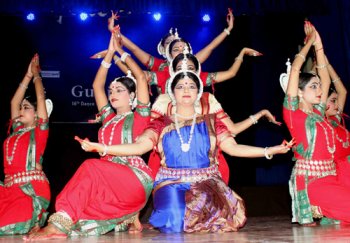 Meera Das and group 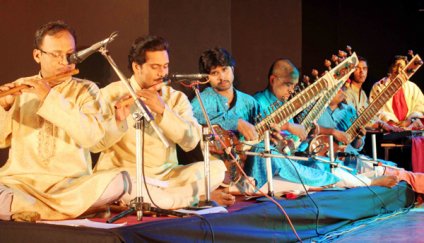 Tala Mahodadhi  Malabika and Lopamudra 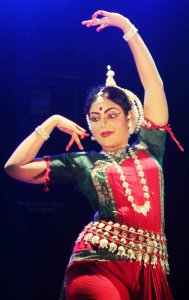 Shibani It was followed by the young dancers of Gunjan Dance Academy who danced in praise of Sun God, Surya. The image of Surya, with a charioteer driving horses across the sky was imaginatively choreographed by Meera Das for the junior dancers. They all danced harmoniously, never looking at anyone for any cue. They executed their steps correctly. It was a good idea to give an experience of a stage performance to the up and coming dancers. Devi stuti by Shibani had a devotional mood. The visage of the dancer registered expressions of the beautiful and fearsome Goddess, who astride a lion, holding a trident, vanquishes the demon Mahisha et al, all portrayed appropriately. The iconic image was sculpturesque with weapons, the vahana, the animal on which the Goddess rides and so on creating a world of mythological beings. Shibani with her large eyes and mobile face was successful in creating those images effectively. Malabika and Lopamudra, two young disciples, have received thorough training in Odissi under Meera Das, as was evident from the very stances they took in a duet number. The melodious Desh raga pallavi unfolded with verve and grace, the two dancers often creating symmetrical patterns, and at times mirror images. Nritta (pure dance) in pallavi sparkled with ukutas and patterns, creating interesting visuals. Both the dancers acquitted themselves well giving an impression that they are aiming at a professional level and are bright stars of Gunjan Dance Academy. Naba Kishore Mishra, currently holding professor’s post at Utkal University of Culture, Bhubaneswar, is a seasoned artist. His unfolding of story of Kaivat, who refuses to ferry Lord Rama across, unless he washes his feet was presented in a more lokadharmi, realistic and popular mould. The argument indeed is a poetic conceit, because Kaivat argues that when Lord Rama touched the stone, it turned into a beautiful woman, referring to Ahalya episode. He, a poor boatman, could not afford to have his boat turned into a woman. Lord Rama allows the devotee to wash his feet before he ferries him across the river. Kaivat gathers the sand from the ground on which the Lord had walked, placing it on his head as a blessing. The portrayal indeed was a touching one. One would have enjoyed it more had it been performed with restraint and less overdone abhinaya. 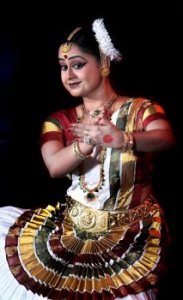 Ayswaria Wariar Mohiniattam exponent Ayswaria Wariar from Baroda, participated in the festival under the scheme of Kerala Sangeet Natak Akademi, presenting thematic aspect using Kalidasa’s Shakuntalam, specially written and composed with Sopanam music. Ayswaria has a good stage presence and a sense of designing costume to suit the character of Shakuntala. Selecting a few key incidents of the well known story, King Dushyanta’s hunting a deer, coming to the hermitage, meeting with Shakuntala, gandhrava vivha, Dushyanta’s promise to send for her after he returns to his kingdom, Shakuntala’s inability to produce the ring, king’s loss of memory on account of the curse of Durvasa and not recognizing Shakuntala, her anguish when accused of lies, her anger addressing Dushyanta as Anarya, uncivilized one, utter dejection, conveying the state of women who are deceived even today by males ,with a touch of contemporary resonance, Ayswaria ‘s attempt was indeed sincere. However, the abhinaya number was rather too long for an overcrowded program for one evening with the result that there was a very thin audience who stayed back. Aswariya would do well to keep another CD for a briefer version of Mohiniattam repertoire to suit the timings in such a conference. Her abhinaya was intense and she succeeded in projecting the inner turmoil, helplessness, agony, and righteous anger when accused by Dushyanta for ensnaring men with wily attempts. In spite of her dignity, Shakuntala bursts forth addressing him as Anarya. That was a dramatic moment. Ayswaria did not show Shakuntala being taken away by apsara, as in the play. She ended on a note of begging mother earth to accept her. Her helplessness makes her beg mother earth, but in the case of Sita, mother earth takes her by opening up. Ayswaria of course did not suggest that mother earth rescued Shakuntala. The music was composed to project the right bhava, expression of pathos and anguish. Ayswaria gave a mature performance. The libretto did not depict sequences in linear order. It had the technique of flashback. That was innovative and looked interesting. The amorous scenes were suggestive. Third day The evening began with young dancers, disciples of Meera Das performing a prayer in praise of Lord Ganapati with stanza Vakratunda mahakaya. Two dancers, one in front with hands in front and the other standing behind suggesting ears of Lord Ganapati, with four arms created an image of Ganapati. The other four dancers arrived from four directions as devotees and performed in unison, describing the deeds of the Lord in a devotional mood. It was obvious that Meera Das has taken pains to train them well with the result that the synchronization was flawless. It was a pleasure to watch a young group of dancers performing joyously. From Bangalore came Sangeeta Iyer, who also in her Mohiniattam dwelt on theme of Shakuntala. But her approach was different from Ayswaria’s. It was based more on Kalidasa’s narrative and was suggestive of key incidents. Sangeeta explained that their performances were organized by the Kerala Sangeet Natak Akademi and they were also presenting the same theme in the tour of various cities. However, since Sangeeta’s presentation was within an adequate time frame, it made a good impact. The agony and helplessness of Shakuntala came through various moments. Both in libretto and music it was different from Ayswaria’s dance choreography. Sangeeta’s pure dance movements were graceful and expression restrained and controlled 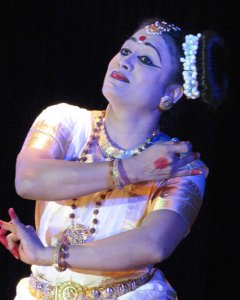 Sangeeta Iyer 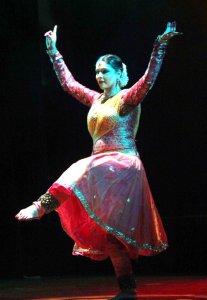 Vidha Lal Vidha Lal, the Jaipur gharana Kathak exponent, a disciple of Geetanjali Lal from New Delhi, took to the stage with her scintillating Kathak movements, breathtaking chakkars, turns, and glamourous stage presence. Her stamina and energy, coming dot on sam, covering the stage with amazing speed circling and concluding the movements won her rounds of applause. The audience, from the word go, seemed to be with her and she regaled them with joyous abandon. Taking Baiju Bawara’s Hari Har composition, describing their individual epithets, with suggestive hand gestures and expressions, Vidha left none in doubt that she has a complete command over the technique and an ability to project her image with a killer instinct. Embellishing the images of Krishna and Shiva, she danced in a flawless manner, casting a spell. In Tarana, she wove intricate footwork, jugalbandi, took chakkars, wove patterns with her arms round her neck and face, moved wrist upwards and in graceful gats, like rukhsar ki gat, or even suggestive ghunghat, looking at her beloved nayak in an alluring manner. Vidha used Kathak vocabulary with aplomb and displayed her choreographic talent. Not for nothing she has been hailed as a rising star in the Kathak firmament. She did her guru proud and won appreciation of the audience for a mesmerizing performance. 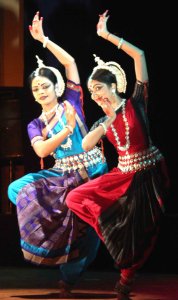 Puspa Panda and Sasmita Panda In the following duet by two sprightly Odissi disciples of Meera Das, Puspa Panda and Sasmita Panda rendered abhinaya to an Odiya song “Sajani lo”, describing Krishna’s beauty in a captivating manner. Krishna’s Rasalila, his vanquishing Bakasura and serpent Kaliya were choreographed by Meera Das with suggestive touches. Both of them danced joyously with youthful exuberance and impressed the connoisseurs with their talent. The finale by Isha Satpathy, another disciple of Meera Das now settled in Dubai, conducting a branch of Gunjan Dance Academy there, performed to Odiya composition “Bibhushana Puspe” dwelling upon Sita’s exquisite beauty. I got a little confused when the announcer mentioned about Rama and Sita’s wedding. But essentially it was about Sita. A passing reference was there about Rama breaking the bow. Isha performed with involvement. Fourth day As often happens in cultural events in India, the programme started an hour late on account of some delays as the guests of honour arrived late. In the beginning, renowned singer Shyamamani Devi was felicitated and honoured with Nibedita Patnaik Samman 2012. She rendered two songs in her melodious voice, which indeed were much appreciated by the audience. 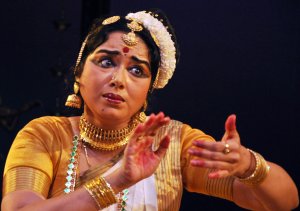 Gopika Varma However, it was in Yagnaseni, a solo recital based on Drauapdi’s plight, written by Kavalam Narayana Panicker in a verse form that Gopika was in her element. Gopika has a commanding stage presence. Draupadi recalls her own plight, when Bhima drags her to battlefield and anoints her hair with Dushashan’s blood as revenge. Drauapdi asks Lord Krishna what is her victory? Did she look forward to such an end? She was not asked about her wish and was ordered to be wife of five Pandavas. She was pledged in a game of dice, humiliated and only Krishna as her sakha (friend) had saved her. She surrenders to Lord Krishna. The unfolding of events of Mahabharata was well conceived and with total involvement Gopika enacted them with mastery. A brilliant dancer, she left an indelible impression with her performance. ‘Meera - a divine love story’ in a dance-drama form choreographed by Meera Das was the main attraction of the evening. Guru Gangadhar Pradhan had suggested to her to choreograph and was to assist her, but unfortunately he passed away. To fulfill his wish, Meera with the help of poet, scholar and critic Kedar Mishra’s libretto and storyline choreographed the dance-drama, using Meera’s immortal songs sung by Nazia Alam. Meera ‘s songs ‘Hari mai to prem diwani’ to the one where Meera gives up everything for Lord Krishna and dances ‘Ghunghroo bandh Meera nachi re’ and her merging with Lord Krishna, Meera Das in a seamless manner wove events, which had instant appeal. The group of dancers, impersonating Rana, servant, trails by Rana, Meera’s merging with Krishna in a temple, the mime artist Madhu from Hyderabad playing role of Krishna, other disciples as gopis playing Rasalila with Krishna et al were performed neatly, keeping interest of the audience intact. The use of a door frame with a transparent screen was imaginative as it captured moments of Meera’s merging with Krishna and disappearance of Meera when she merged with him. The teamwork was praiseworthy. Meera Das as a choreographer succeeded in presenting a known story in an interesting manner. The lighting, costumes and music were of a professional standard. 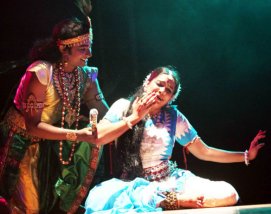
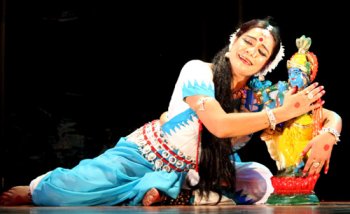
‘Meera - a divine love story’
The finale was a surprise number titled Fusion, in which Madhu, Meera and Gopika participated improvising on the spot to selected music. With back to the audience Madhu, then Meera and Gopika facing audience, three standing in the centre with their shadows falling on the framed screen, they created images of birds, animals, deer, elephant, lion, flowers and succeeded in a diagonal line showing the flowing river. Brief but captivating, the Fusion number won rounds of applause. Madhu, a disciple of Nirmal Goswami, is a Bismillah Khan Yuva Purskar awardee for mime. He has a pleasant stage personality and very good command over his expression and body movements. Meera and Gopika well versed in their respective idioms of Odissi and Mohiniattam performed with natural ease and all three put up an interesting fusion. 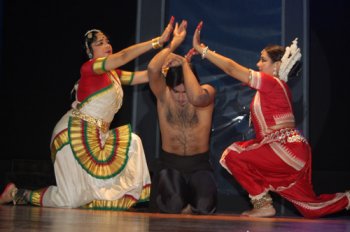
Gopika, Madhu and Meera Das
Dr. Sunil Kothari is a dance historian, scholar, author and a renowned dance critic. He is Vice President of World Dance Alliance Asia Pacific India chapter, based in New Delhi. He is honored by the President of India with Padma Shri, Sangeet Natak Akademi award and Senior Critic Award from Dance Critics Association, NYC. He is a regular contributor to www.narthaki.com, the roving critic for monthly magazine Sruti and is a contributing editor of Nartanam for the past 11 years. |